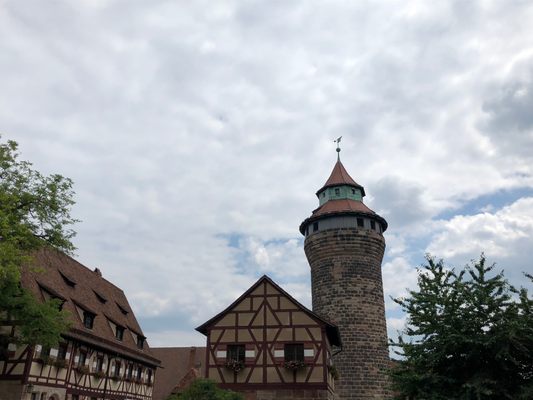About
Nuremberg and the castle it was centered around have a long and storied history. The town was part of the Holy Roman Empire (HRE), which lasted from the rule of Charlemagne in the 800s until the founding of the German Empire in 1871. For political history, a millennium is a really long time. The United States has been around for less than a quarter of that.
The Holy Roman Empire morphed throughout its history to include different states, factions, and kooky leaders. Who inherited the title "Roman Emperor" had little to do with Romans and everything to do with the Roman Catholic Church and the lords of the various Germanic lands, who conquered what had been most of the Western Roman Empire after the year 405.
Voltaire once said that the HRE was neither Holy nor Roman nor an Empire. Whatever it was, it was not a highly centralized state, but one made up of hundreds of semi-allied fiefdoms, states, and cities—at times covering most of Europe except for England and western France. For much of its history, the HRE included Italy and Burgundy, in addition to what we now call Germany.
As an important city during the life of the Holy Roman Empire, Nuremberg hosted legislators and court sessions. And like any respectable town in the High Middle Ages, it had a castle.
In the 19th century, the infamous and enigmatic Kaspar Hauser is said to have been housed in the Luginsland Tower of the castle where he was later to be imprisoned as a "vagabond." In the 20th century, this same tower was to become the site of a popular Hitler youth hostel that housed hundreds of the leaders of the movement.
Though damaged during World War II, the castle has been restored to its original state. The Double Chapel in the center of the castle remained unscathed during the War. The castle offers tours of the Double Chapel and the Imperial Castle. The Imperial Castle Museum contains an array of artifacts of historical interest, including antique weaponry, official documents, and the Holy Roman crown jewels.
Visitors can also climb the Sinwell Tower to get a great view of the city beneath the castle. The "Deep Well"—the site's medieval water source, descending 50 meters down into the castle rock—is also worth a look and a tour guide provides an immersive demonstration on the hour, every hour.
What's more, the old emperor's mews now features a youth hostel where you can sleep like a king ... or at the very least like a king's horse.
Related Tags
Know Before You Go
The Castle is relatively easy to find, situated on the northern edge of Nuremberg's old city center. The closest tram stop is Tiergärtnertorplatz (tram number 4) and bus number 36 will take you directly to Burgstraße. The castle is open from 9 a.m. to 6 p.m. from April to September, and 10 a.m. to 4 p.m. from October to March.
Community Contributors
Added By
Published
May 9, 2010
























































































